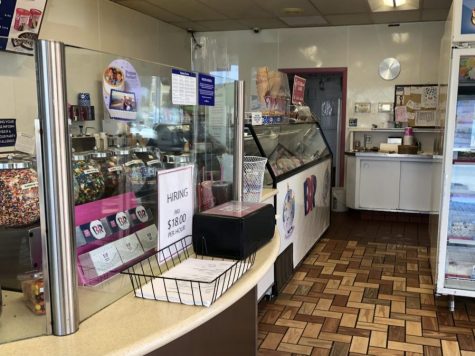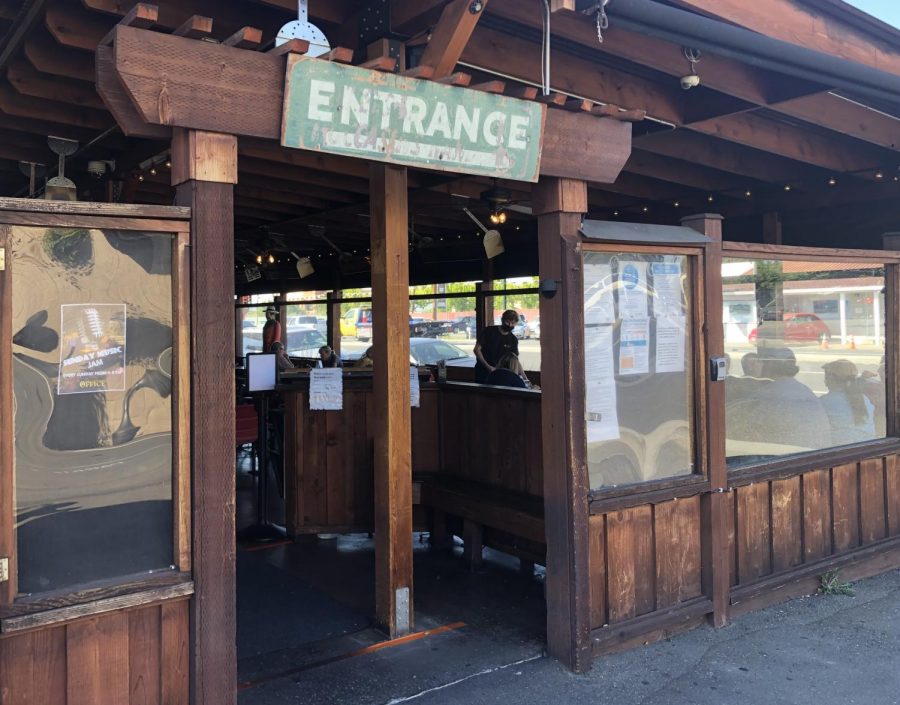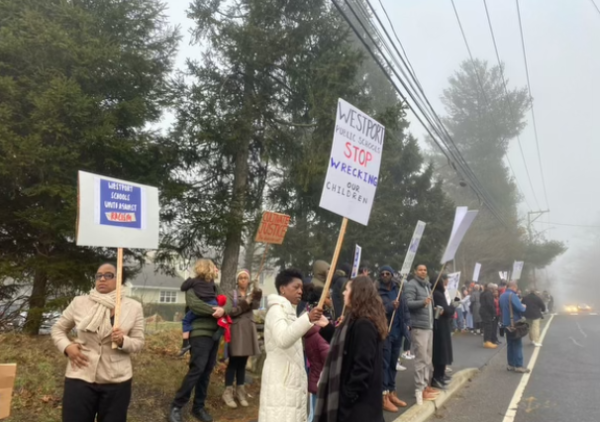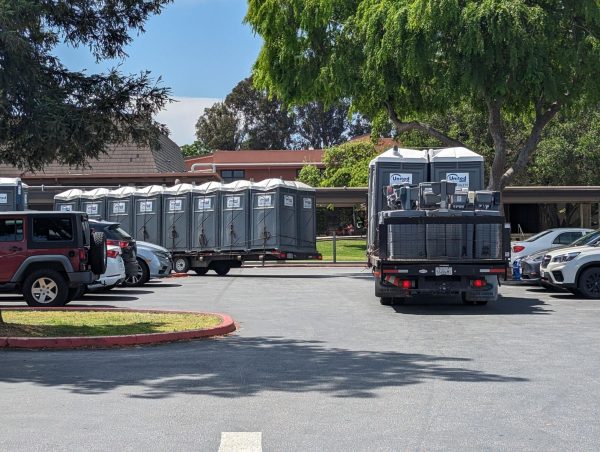Businesses respond to an uncertain labor market
Local restaurants, such as The Office, are increasing their capacity as California nears its reopening date of June 15.
June 3, 2021
As the state of California nears a planned reopening date of June 15, many local workers and business owners are grappling with how to adapt to a post-pandemic world. Reports of labor shortages both nationally and locally suggest that the lack of available workers will inhibit some businesses, preventing them from getting back to full capacity.
The debate around the cause and extent of the shortage has vaulted itself into the public consciousness in the past month. Factors such as hesitancy to return to work, problems with inadequate childcare, and overly generous federal unemployment benefits have all been cited as potential causes.
As the United States economy rebounds from the pandemic, increasing the number of jobs has been a critical federal and California state policy goal. The Labor Department recently reported a gain of 266,000 jobs nationwide for all industries in the month of April. Those results, far lower than expected and significantly down compared to a gain of 770,000 jobs in March and 536,000 jobs in February, fueled the business community’s concerns about the negative impact of a potential labor shortage, with representatives in the hospitality and entertainment industries leading the charge.
The Hospitality Industry is Recovering
Despite the public outcry and ominous national data, Dr. Enrique Lopezlira, the director of the Low-Wage Work Program at the University of California Berkeley Labor Center, maintained that the reports of a labor shortage were contrary to the statistics presented by the government.
Lopezlira said, “While media outlets have reported anecdotal evidence of businesses experiencing labor shortages, the latest labor market data does not show that this is in fact the case. This is especially true in the leisure and hospitality industry – which includes restaurants – where most of the anecdotal evidence is coming from.”
In particular, the industries that complained the most about labor shortages had in fact achieved “notable gains” during the month of April, according to the Labor Department, adding 331,000 jobs in April while other industries, mainly temporary help services, had a net loss. Despite those gains, the leisure and hospitality industries are still well below pre-pandemic employment levels – down 2.8 million jobs or 16.8% nationwide – despite having added 5.4 million jobs this year.
In California, the labor market seems to be rebuilding as the state recovers from the effects of the pandemic.
“Leisure and hospitality, along with other services, were the hardest hit sectors during the pandemic,” Lopezlira said. “However, these sectors have accounted for over two-thirds of California’s job gains over the past three months. Overall, the latest jobs data show a labor market that is improving but still has a long way to go until full recovery.”
However, Lopezlira did acknowledge that some laborers were not returning to their jobs.
Lopezlira said, “Currently, there are about 4 million workers nationwide who left the workforce during the pandemic and have not returned, with about half a million of those workers in California. It’s hard to identify one single reason for these workers remaining on the sidelines, but it’s probably due to a number of factors. For instance, some workers are taking care of children or elderly relatives, while others may have health concerns about returning to work, particularly if the job involves interacting with the public and doesn’t offer paid sick leave.”
Some National Chains Require Incentives to Grow
As the pandemic has begun to subside, many chain restaurants have announced expansion plans to new locations as they return to their more lucrative business models.
Despite these plans, some chains are reporting that labor is hard to find and are taking necessary steps to attract the needed employees.
For example, Chipotle announced plans to raise the average hourly wage to $15 an hour, with starting crew pay ranging from $11 to $17 an hour, in an effort to increase their hiring by 20,000 employees by the end of June 2021.
Tyler Benson, Chipotle’s manager of external communications, spoke to the massive amounts of labor the company was planning to add and the company’s plans for the future.
Benson said, “We are seeing increased staffing needs to meet our current demand, and we are building our teams for future growth. We have 2,800 restaurants today, and we plan to have 6,000 restaurants in the future.”
To deliver that growth, Chipotle has added benefits to attract workers as the company emerges from the pandemic-related restrictions. Specifically, Chipotle has increased the availability of advancement opportunities for entry-level workers. In addition, the company has added a $200 bonus for crew members and a $750 bonus for general managers and apprentices if they are able to refer a new employee, reflecting Chipotle’s immediate need for more workers.
Even so, Benson did still maintain that some workers were not ready to resume their jobs. Talking about a variety of factors, Benson focused on the commonly-cited reasons for workers not returning to their positions.
“Parts of the country are at different stages of recovery, and we have heard anecdotally that some people are not ready to return to work due to childcare or health concerns. Other people are not in a hurry to get back to work due to the availability of generous stimulus money and unemployment benefits,” Benson said.
Some Hard-Hit Local Small Businesses are Starting to Rebound
For small local businesses, the beginning of the pandemic presented a grim view of the future. With massive uncertainty and a slowdown in profits, small businesses had to grapple with issues that a chain like Chipotle could not fathom.
A study of small businesses in the services sector by the Federal Reserve of New York noted that 35% of small businesses tracked prior to the pandemic are still closed and have been inactive for 20 or more weeks. Furthermore, only 3% of currently closed small businesses can expect to reopen, highlighting the challenges that small businesses nationwide face.
Despite the challenges nationwide, some local businesses in San Carlos report that business is picking up, and they are having limited difficulty convincing their employees to return to work. The Office Bar and Grill, a self-declared local “neighborhood hangout and sports destination,” according to their website, has not been faced with any issues in terms of labor up until this point.
Jeff Boebekker, the general manager of The Office Bar and Grill, recounted how the business had shut down early last year, just as “every restaurant had to.” Speaking to the rebound, Boebekker talked about how the business stayed afloat with minimal funds and is looking towards June 15 as a telling sign of things to come.
“We basically took 33% of our sales, and that’s what we had for the entirety of last year,” Boebekker said. “Now, we are starting to do events again, and I’m starting to see consumers coming back. With June 15th being the day we are doing a 100% reopening, business is picking back up due to our availability of outdoor seating.”
The Office and other San Carlos-based restaurants did follow the nationwide trend of shutting down at the beginning of the pandemic. Yet, the reported trend of workers not coming back does not seem to hold up at this establishment.
“Here, we’re happy to announce that every person that we had before [the lockdown] came back,” Boebekker said. “We didn’t have any problems […] People were waiting to come back to work.”
This local experience may be influenced by several factors. One possible explanation would be that San Carlos’ high minimum wage ($15.24) and cost of living in the Bay Area could mean that the government-issued unemployment benefits and stimulus checks distributed over the past year have not covered basic needs, encouraging people to seek employment and/or return to work.
Talking about the prospect of a labor shortage nationwide, Lopezlira said, “If, in fact, businesses are experiencing labor shortages, then that means wages are not as high as they need to be to incentivize workers to supply more labor. So we should see evidence of significant wage acceleration. However, wage growth in April 2021 was only 1.2% higher than a year earlier.”
However, Chipotle’s decision to raise the minimum wage may reflect the changing dynamic as businesses scale back up their operations and compete for employees. Other nationwide brands, such as McDonald’s and KFC, are also increasing their wages. Chipotle may be raising the standard in response to competition, but it could also be a sign of limited labor in certain markets.
It remains to be seen whether the local restaurants will have hiring issues in the future as they continue to expand.
Boebekker said, “We hope people feel comfortable. Our goal is to continue [full steam ahead], and I think we are well-positioned to do just that. Also, we have been trying to hire additional people just because of how busy it has been.”
High School Students May Benefit From the Increased Demand for Workers

With summer quickly approaching, it is prime season for high school students to apply for summer jobs. For Anna Burford, a junior from Carlmont, securing a job at Starbucks during the pandemic was not too difficult.
“I’m satisfied with the amount I’m being paid,” Burford said. “[The wages are] higher than expected, and especially now, I’m earning hazard pay, so I’m making a highly satisfactory amount of money right now.”
Moreover, the pandemic may benefit teen workers in the long run. Lopezlira maintained that “strong post-pandemic recovery would disproportionately help young workers, especially in terms of higher wages.”
At a local Baskin Robbins in downtown San Carlos, a place where high school students in the local area frequently apply to work, wages were recently being advertised as beginning at $18, well above both the state and federal minimum wage rate, reinforcing Lopezlira’s point.
Benefits and longer workdays are also benefiting teenagers during this summer work season.
Burford said, “This summer, I plan on working anywhere between 16-20 hours per week. [Working at Starbucks] is a much higher quality job than I expected, [as it] offers many benefits and gives me a lot of freedom.”
Burford noted that hiring needs have been amplified by the summer season, evident in her observation that Target is advertising available positions. As the summer months near, Lopezlira offered advice for companies to attract talent.
For companies struggling to attract workers, Lopezlira reinforced the need for a living wage and attractive benefits.
“In general, [companies should pursue] policies that create good quality jobs: wages that are sufficient to cover basic living expenses, working conditions that are safe, stable predictable work hours, basic benefits, health care, paid sick leave, vacation time,” Lopezlira said.
Lopezlira stressed the importance of the role of businesses in bringing back into the workforce the 4 million U.S. workers who have not returned to their jobs.
When posed with the question of whether or not businesses can attract workers back in sufficient numbers, Lopezlira ended on an optimistic note.
Lopezlira said, “If employers offer good quality jobs and pay wages that allow workers to meet basic living expenses, then the answer is more likely to be yes.”
This story was originally published on Scot Scoop News on May 31, 2021.
































![IN THE SPOTLIGHT: Junior Zalie Mann performs “I Love to Cry at Weddings,” an ensemble piece from the fall musical Sweet Charity, to prospective students during the Fine Arts Showcase on Wednesday, Nov. 8. The showcase is a compilation of performances and demonstrations from each fine arts strand offered at McCallum. This show is put on so that prospective students can see if they are interested in joining an academy or major.
Sweet Charity originally ran the weekends of Sept. 28 and Oct. 8, but made a comeback for the Fine Arts Showcase.
“[Being at the front in the spotlight] is my favorite part of the whole dance, so I was super happy to be on stage performing and smiling at the audience,” Mann said.
Mann performed in both the musical theatre performance and dance excerpt “Ethereal,” a contemporary piece choreographed by the new dance director Terrance Carson, in the showcase. With also being a dance ambassador, Mann got to talk about what MAC dance is, her experience and answer any questions the aspiring arts majors and their parents may have.
Caption by Maya Tackett.](https://bestofsno.com/wp-content/uploads/2024/02/53321803427_47cd17fe70_o-1-1200x800.jpg)
![SPREADING THE JOY: Sophomore Chim Becker poses with sophomores Cozbi Sims and Lou Davidson while manning a table at the Hispanic Heritage treat day during lunch of Sept 28. Becker is a part of the students of color alliance, who put together the activity to raise money for their club.
“It [the stand] was really fun because McCallum has a lot of latino kids,” Becker said. “And I think it was nice that I could share the stuff that I usually just have at home with people who have never tried it before.”
Becker recognizes the importance of celebrating Hispanic heritage at Mac.
“I think its important to celebrate,” Becker said. “Because our culture is awesome and super cool, and everybody should be able to learn about other cultures of the world.”
Caption by JoJo Barnard.](https://bestofsno.com/wp-content/uploads/2024/01/53221601352_4127a81c41_o-1200x675.jpg)













